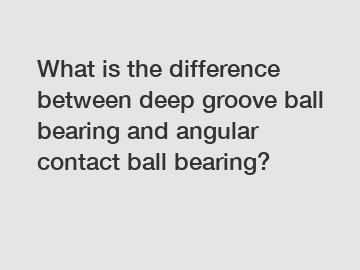What is the difference between deep groove ball bearing and angular contact ball bearing?
What is the difference between deep groove ball bearing and angular contact ball bearing?
In the field of machinery and equipment, ball bearings are widely used to reduce friction and bear radial and axial loads. Two commonly used types of ball bearings are deep groove ball bearings and angular contact ball bearings. Although they both serve the same purpose, there are several significant differences between them. In this article, we will explore these differences and understand the unique characteristics of each type.
Deep Groove Ball Bearing.

A deep groove ball bearing, as the name suggests, has a deep groove that enables it to support both radial and axial loads. It consists of an inner ring, an outer ring, a cage, and a set of balls. The raceway grooves on the inner and outer rings are arc-shaped to facilitate smooth rolling.
1. Structure and Design:
Deep groove ball bearings typically have a single row of balls, which allows them to carry both radial and axial loads in either direction. They have a higher load-carrying capacity compared to other types of bearings. The contact angle is usually 0 degrees, resulting in a pure radial load-bearing design.
2. Applications:
Deep groove ball bearings are widely used in various applications, such as electric motors, household appliances, automotive components, and industrial machinery. They are particularly suitable for high-speed operations and can accommodate moderate axial loads.
Angular Contact Ball Bearing.
An angular contact ball bearing, on the other hand, is specifically designed to withstand combined radial and axial loads in a particular direction. It consists of an inner ring, an outer ring, a cage, and a set of balls. The raceways are designed to create a specific contact angle, allowing the bearing to support both axial and radial loads.
1. Structure and Design:
Angular contact ball bearings have a double row of balls, which are arranged in a contact angle with the inner and outer rings. This design enables them to carry both radial and axial loads while providing high rigidity and precision. The contact angles are usually 15 degrees, 25 degrees, or 40 degrees, depending on the application requirements.
2. Applications:
Angular contact ball bearings find applications in various industries, including aerospace, machine tools, pumps, and compressors. They are commonly used in pairs or sets to accommodate complex load combinations, especially in scenarios where thrust is involved.
Conclusion.
In summary, the key difference between deep groove ball bearings and angular contact ball bearings lies in their design and load-carrying capabilities. Deep groove ball bearings are designed for both radial and axial loads in any direction, while angular contact ball bearings are specifically designed to handle combined loads in a particular direction. The choice between the two depends on the application requirements and the type of loads expected.
Both types of bearings play a crucial role in the smooth operation of machinery and equipment. If you are unsure about which type is suitable for your specific needs, it is always recommended to consult with a bearing expert. They can provide valuable guidance based on their knowledge and expertise.
If you have any further questions or need assistance in selecting the right ball bearing, please do not hesitate to contact us. Our team of experts is always ready to help you make an informed decision and ensure optimal performance for your applications.
Want more information on Auto part ME523197 clutch hydraulic release bearing, wholesale spherical roller thrust bearing, Semiconductor manufacturing thin section bearings? Feel free to contact us.


